| Columns Retired Columns & Blogs |
Another amp that costs more than a sports car that does not offer anything close to state of the art performance.
Disappointing.
Because the CH Precision M1.1 is so heavy (165lb), I drove the 45 miles to Michael Fremer's home with my Audio Precision SYS2722 system (see the January 2008 "As We See It"), cables, noninductive power resistors, and analog and digital oscilloscopes, and I set up everything on a table in his garage. Because I knew from experience that the AC outlets in the garage are on a circuit with a 15A breaker, I ran two long extension cables—one for the test gear, one for the amplifier, which has two AC cords—to an outlet in the house that has a 20A circuit.
I performed a full set of measurements with one of the two amplifiers configured as Michael had done for his auditioning: "Monaural" mode, 0dB gain adjust, 20% global negative feedback, and driven via the balanced input. I repeated some of the tests with the high-impedance unbalanced input and with 0% and 100% negative feedback (footnote 1).
Before I test an amplifier, I precondition it with both channels driving a 1kHz tone for an hour at one-third power into 8 ohms, which is the most thermally stressful condition for an amplifier with a class-AB output stage. Because of time constraints, however, I preconditioned the M1.1 for 15 minutes. At the end of that time, the top panel was slightly warm at 82.4°F (28°C); aiming my infrared thermometer through the slots in the top panel at the heatsinks, the temperature was 101.5°F (38.6°C). I continued to monitor temperature, but the amplifier didn't get any warmer throughout the testing.
The voltage gain at 1kHz from the speaker terminals into 8 ohms measured 23.5dB for the balanced input, but, unusually, 6dB higher from the unbalanced input. Both inputs preserved absolute polarity (ie, were noninverting); the XLR jack is wired with pin 2 hot. The balanced input impedance was a usefully high 90k ohms at 20Hz and 1kHz, dropping inconsequentially to 58k ohms at 20kHz. The unbalanced input impedance was 45k ohms at 20Hz and 1kHz, 21k ohms at 20kHz.
The output impedance with 100% feedback, including a 6'-long, spaced-pair speaker cable, was a low 0.1 ohms across the audioband. With 20% feedback, it rose to 0.24 ohm at low and middle frequencies, and 0.27 ohm at the top of the audioband. But when I started to measure the CH amplifier's small-signal frequency response, I realized that I had left my standard simulated loudspeaker at home. However, this output impedance should result in the modulation of the amplifier's frequency response with this load by close to ±0.25dB. The M1.1's frequency response into 8 ohms (fig.1, blue trace) was flat to 20kHz and down by just 0.5dB at 60kHz; a 10kHz squarewave was therefore reproduced with very short risetimes (fig.2). A 1kHz squarewave was perfectly square (not shown). Though the ultrasonic output rolls off a little earlier into lower impedances, the response into 2 ohms (red trace) was down by just 0.3dB at 20kHz.
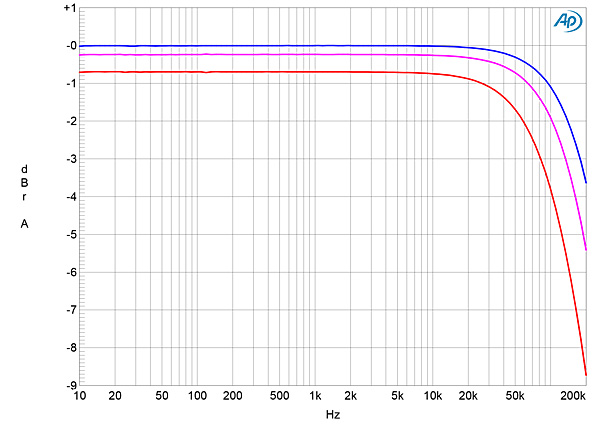
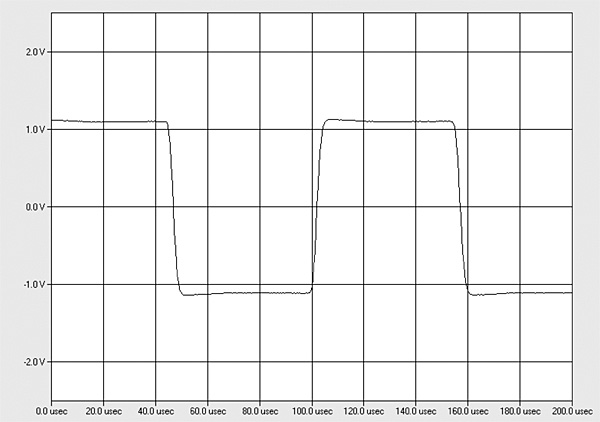
The unweighted, wideband signal/noise ratio, taken with the unbalanced input shorted to ground and ref. 1W into 8 ohms, was 76.4dB, improving to 83.6dB with the measurement bandwidth restricted to 22Hz–22kHz and to 89.3dB with an A-weighting filter in circuit. Spectral analysis of the low-frequency noise floor (fig.3) indicated that there were AC power-supply–related spuriae at 60Hz and its odd-order harmonics, these presumably due to magnetic interference from the huge power transformer. Other than the spectral components at 60Hz and 180Hz, which were at a still-low –93dB and –97dB, these spuriae all lay close to –110dB (0.0003%), and the random noise-floor components were all extremely low in level.
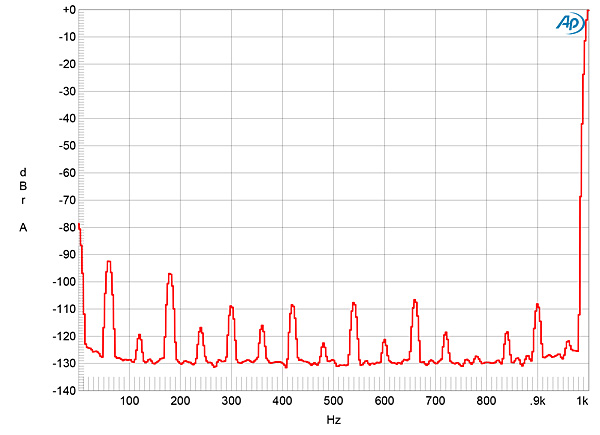
When I started testing the amplifier's output power, I fed the balanced input at 1kHz tone at 188mV, which resulted in exactly 1W into 8 ohms; the M1.1's meter read 2.3W.4 In its mono mode, the CH M1.1's maximum output is specified as 200W into 8 ohms (23dBW), 350W into 4 ohms (22.4dBW), and 600W into 2 ohms (21.8dBW). With clipping defined as when the THD+noise in the output reaches 1% and with the M1.1 set to 20% feedback, I measured a clipping power of 260W into 8 ohms (24.15dBW, fig.4). Increasing the feedback to 100% gave the same clipping power (fig.5), but the distortion is very much lower at all powers below 200W into 8 ohms. Into 4 ohms I measured 440W (23.4dBW, fig.6) and into 2 ohms 700W (22.4dBW, fig.7). I don't hold the wall voltage constant during these tests; it dropped from 122.5V AC with the amplifier idling to 118.5V AC at the measured clipping power into 2 ohms. The shortfall in maximum output power will not be an issue with typical loudspeakers and rooms, but it did puzzle me.
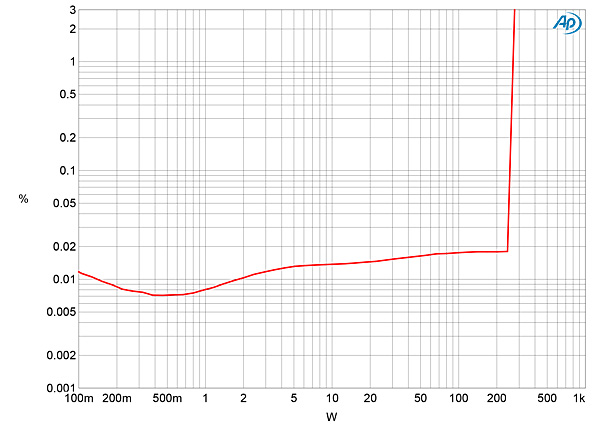
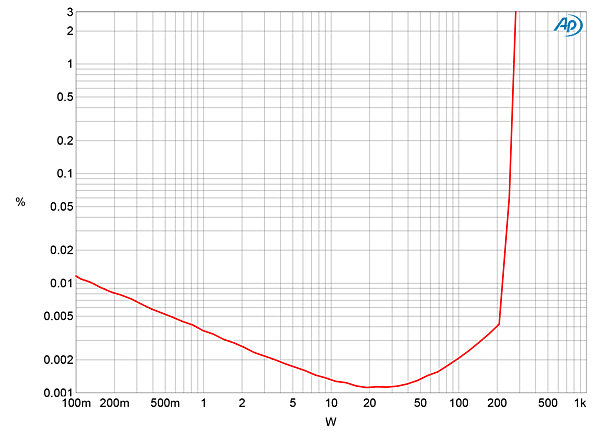
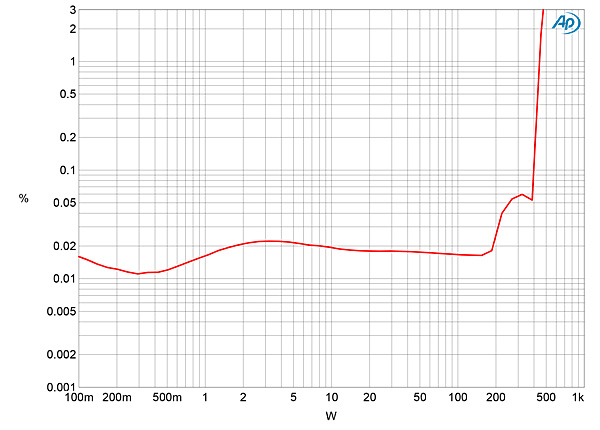
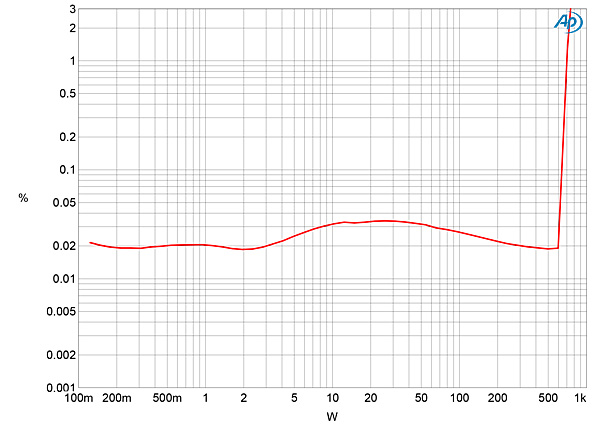
The traces in Figs. 4–7 suggested I examine how the M1.1's percentage of THD+N varied with frequency at 20V, which is equivalent to 50W into 8 ohms, 100W into 4 ohms, and 200W into 2 ohms. With 100% feedback (fig.8), the percentage of THD+N was extremely low into 8 ohms and 4 ohms in the bass and midrange, with the rise in the treble due to the decrease in open-loop voltage gain as the frequency increases. However, into 2 ohms (fig.8, red trace), the amplifier's distortion was 10 times higher in the midrange than it was into 8 ohms and even higher at low frequencies. Repeating the test with 20% feedback, which is how Michael did all his auditioning, the THD+N was higher into 4 and 8 ohms (fig.9, magenta and blue traces) but similar to the 100% feedback behavior into 2 ohms (red trace). Even so, it still lay below 0.1% below 10kHz.
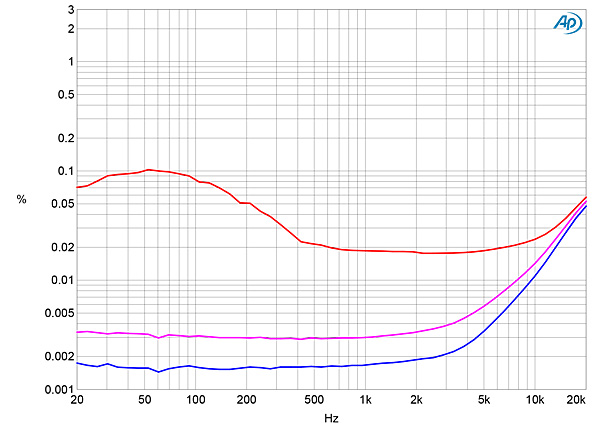
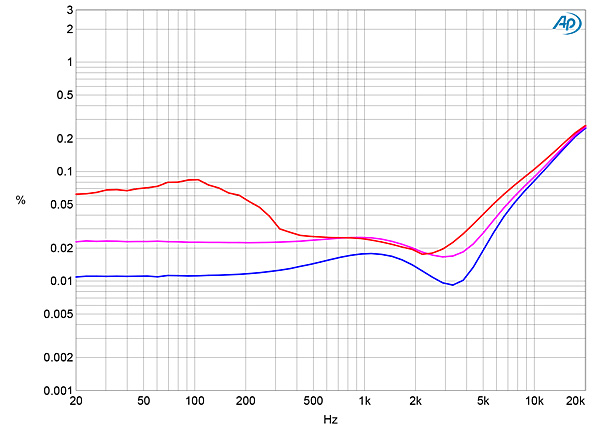
The THD+N waveform with 20% feedback at 100Wpc into 8 ohms (fig.10) indicates that while the distortion was low, at 0.018%, there were higher-order components present. With a low-frequency tone at 100Wpc into 8 ohms (fig.11), the second and third harmonics were the highest in level, at –93dB (0.002%) and –87dB (0.005%), respectively, with many higher-order harmonics visible. Repeating the analysis with 100% feedback (fig.12) kept the third harmonic at the same level, but the second harmonic dropped by 10dB and the higher-order products almost disappeared.
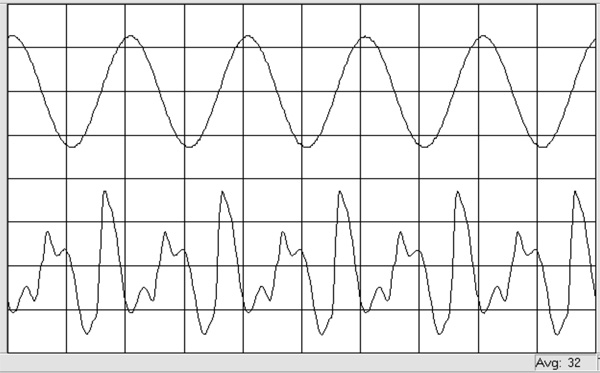
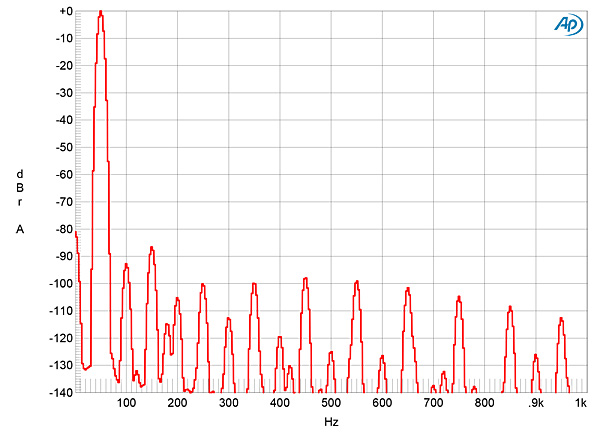
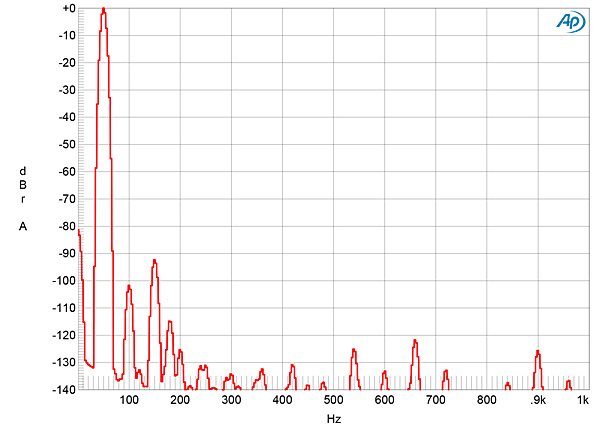
The reduced linearity of the M1.1's circuit at high frequencies meant that when tested with an equal mix of 19 and 20kHz tones, the amplifier produced relatively high levels of intermodulation distortion, even at moderate powers (fig.13). The difference product at 1kHz lay at –66dB (0.05%) with many higher-order products present. This graph was taken with 20% feedback; increasing the feedback to 100% gave a much cleaner spectrum (fig.14).
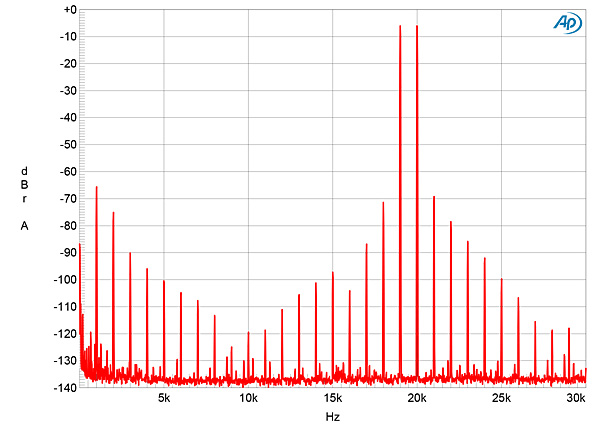
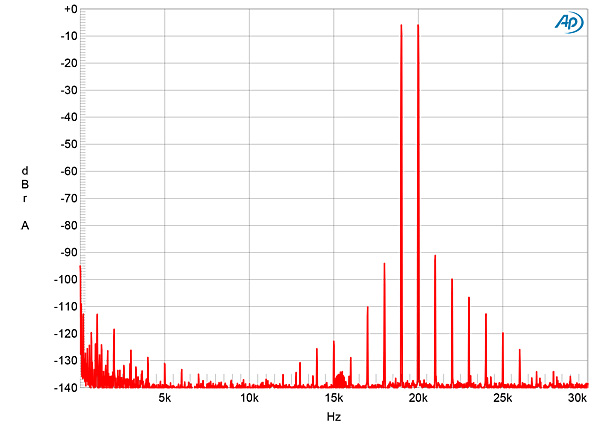
The CH Precision M1.1 is a powerful amplifier, but its measured performance is heavily dependent on the amount of global negative feedback selected. A measurement freak such as I would choose 100% feedback, but I note that Michael found 20% feedback to be the sweet spot when it came to the M1.1's sound quality. And note that no matter the percentage of feedback, this amplifier is more comfortable driving impedances higher than 2 ohms.—John Atkinson
Footnote 2: CH Precision says the meter on the M1.1 shows peak power, not RMS power; the rest of the discrepancy they attribute to a measuring technique that avoids adding components in series with the output signal.

Of "state of the art"? Mine is: "a seriously mis-used and meaningless cliché used by lazy people."

So I'm getting flamed by a guy who thinks you need to spend $5K on each power chord to have a good sounding system.
Given your history of thoroughly misguided and erroneous "journalism" (which, in your case, the term is used very generously), having you slag me is a sign that I'm not wrong.
What I consider "state of the art":
• Amps that produce at least 20dB less distortion and noise than this overpriced brick
• That list, to my knowledge, has only two entries: amps by Benchmark and Devialet
• I'm confident that whatever Bruno Putzeys & Peter Lyngdorf are about to release from Purifi Audio will be way better than this cinderblock as well
• Also, all of these superior products are a fraction of the cost of this lead bar
Fremer, you are definitely that guy that would buy a Bugatti Veyron rather than an Acura NSX or purchase a $10K analog Rolex when a $400 Citizen, solar powered, digital watch keeps better time.

Based on what criteria exactly? Did you experience these amplifiers at all?

... sound quality of this amp when powered through a "Best Buy grade" Audioquest power conditioner. Surely anyone who reads - let alone writes for Stereophile - knows that he should have been using a power conditioner from Synergistic Research.
https://www.stereophile.com/content/synergistic-research-powercell-ac-conditioner-mcintosh-mc462-amp-elac-adante-speakers
Now bring on the 350W/ch Rotel RB-1590:
http://www.rotel.com/product/rb-1590
It's much lighter on both your wallet and your toes.

Rotel RB-1590 doesn't have user adjustable feed-back controls :-) .........

MF liked the way D'Agostino Momentum mono-blocks sounded ....... Momentum has similar output impedance as CH precision, when 20% feed-back is used ........ That output impedance is also close to the output impedance of darTZeel NHB-458 amp :-) ..........

CH precision is smart ....... They know that 'one size fits all' approach may not be a good idea ....... So, they provide user adjustable feed-back controls :-) ........

BTW ..... Pass labs SIT-3 ($4,000) also has somewhat similar 0.25 to 0.26 Ohm output impedance :-) ........

Yeah, I think CH has hit on an interesting feature that audiophile might like. Sort of like letting listeners choose between a range of digital filters from minimum phase to linear. Although this of course will result in more audible differences than otherwise decent digital filters at the edge of audibility.
The problem here I hope is that it does not demonize negative feedback as something "bad" (which IMO it isn't). If some people are OK with the higher harmonic distortion including elevated higher order distortions and higher output impedance (with commensurate lower dampening factor), then so be it.
But let's just make sure to frame this as a "subjective choice" rather than making it some kind of simplistic audiophile "myth" causing all kinds of companies to follow a trend of low negative feedback when there's typically no reason to...

..it's not theory but implementation that matters.

Agreed :-) ........

Wish more audiophile companies could do what CH Precision is doing less expensively :-) ........

that this amp is State of the Art in many areas of performance.
Many reviews from respected magazines with experienced reviewers can attest.
Instead the posts show misanthropic assumptions of equipment none of us have heard.

... exceed the performance of the $4K Benchmark AHB-2 (operating in bridged mode)?

and listen... Only then would you know where and how the amp compares.
The review should be insightful regarding sound quality.
Perhaps you could ask MF to compare them in a follow-up.
Or you could read the several, other reviews on the web and guess.
Or you could do none of the above, and just speculate wildly and assume everyone is lying to you.

... the CH Precision M1.1 is "State of the Art in many areas of performance."
Again, which MANY areas of performance would those be as compared to the Benchmark AHB2?
For your reference:
https://www.stereophile.com/content/benchmark-media-systems-ahb2-power-amplifier-measurements

My statement was a rebuttal of your assertion.
Read the reviews and you tell me... I already read them. lol..

... sound storage and playback via analog disc, then you must have a preference for a less flat frequency response, degraded speed accuracy and pitch stability, higher levels of distortion and worse signal-to-noise ratio, along with the presence of random impulse noises, as compared to a digital system.

In a large active system, bridgeable Benchmark AHB-2 can provide clean linear output with wide bandwidth, fully adequate for powering the tweeters. If DIY is of interest, consider the Neurochrome Modulus-686.
Below tweeter frequencies... Bandwidth is obviously constrained at lower frequencies, and class D is fully adequate, and the inefficiency of class A/B is not justified. In that range, look at ATI 5xxNC family of amplifiers which use Hypex NC500 amplifier modules.
For the subwoofer subsystem, I would suggest class H pro-grade fan cooled amplifiers, and would suggest replacing the cooling fans with suitable very quiet running Noctua fans. Class H is similar to class A/B in the output stage, with tight control provided by a large dose of negative feedback, but modulates switch mode power supply output rail voltage to follow the input signal, keeping it a little above a level that would otherwise clip the output when operating within design range. So it is much more efficient than class A/B. The downside is that bandwidth is lower than is achievable with conventional class A/B.
Horses for courses, etc.

I'm sure there are a lot of dirt poor people in 3rd world countries who could look at your possessions and your lifestyle and say the same about you. Take your "holier than thou" attitude elsewhere.

Well said ACranston
Regards,
Terry

That is among the most foolish comments yet. No one need apologize for owning this amp, or any high performance, high quality product. Should Ferrari owners apologize? Where do you draw the line? Grow up.

MF did not quite like the sound of Boulder 2150 mono-block power amps (Stereophile Class-A) ....... 2150 has very low output impedance and very high damping factor ....... 2150 also has almost 20-Bit resolution (SNR) :-) .........

... why not get a Nagra?
https://www.nagraaudio.com/product/nagra-hd-amp/

That would be a 'bravura' effect :-) .........

Both CH Precision and Nagra are located in the Swiss 'Watch Valley' :-) ..........

darTZeel is also, Swiss made :-) ........
Next MF is gonna review the latest darTZeel NHB-468 monoblock amps :-) .......

The comments section beneath many Stereophile articles are consistently hijacked by a vocal minority of judgmental, know-it alls that simply can't summon the capacity to stifle their negative rantings. I, for one, vote to turn off comments. Another one of my favorite audio review sites did it, and the world just kept on spinning. I would be surprised if Stereophile hasn't considered doing this already. I'd be interested to hear your thoughts in an "As We See It" one of these days.

..simply refuses to get into the comment section; I guess they call it a smartphone for a reason.

My android phone simply refuses to get into the comment section; I guess they call it a smartphone for a reason.
The mobile version of the Stereophile website doesn't show comments.
John Atkinson
Technical Editor, Stereophile

Idee intelligente :-) .........

First, thank you for providing the comments section.
In writing this comment, I am using a Chrome browser on Android, and the comment section becomes available by selecting the desktop site in the pull-down menu in Chrome. As you explained, the comment section is unavailable in the mobile version.
I would suggest that if anyone does not want to read the comments, then perhaps they shouldn't. They always have the option of not reading the comments, regardless which browser they might be using.

I like reading the comments, and sometimes adding my own comments.

... a pair of CH Precision M1.1 amps OR a pair of Luxman B-1000f amps - plus a BMW Z4.
https://www.stereophile.com/content/luxman-b-1000f-monoblock-power-amplifier
https://onahighernote.com/shop/stock-open-box-sales/electronics/luxman-b-1000f-monoblock-ex-demo/
http://www.luxman.co.jp/product/b-1000f

....... or, a Corvette convertible :-) .........

Invasion of the 'know-it-alls' :-) ............

May be Stereophile could come up with an 'app' for the comments section ....... So, people who don't want to read the comments, could turn off the 'app' :-) ...........